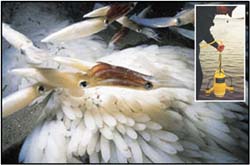
Over the past five years squid has soared past salmon, swordfish, and tuna to become the top seafood species in California by volume and dollar value. The state's harvest of this fast moving mollusk has been nothing short of phenomenal, growing 500 percent since the early 1980s, with a wholesale value of over $30 million; more than double the value of salmon. The "market squid" supports the largest commercial marine fishery both in terms of quantity landed and dollars generated per vessel.
In the early days of squid fishing, boats from as far away as Alaska steamed into California waters to get a piece of the action. There were no catch limits, permits, seasons, or boundaries. This created a growing fear the squid fishery would collapse, as the sardine fishery had in the 1940s, dealing a death blow to the processing industry along Cannery Row. If the squid population collapsed, the affects would be far reaching warned marine biologists. Squid are a key link in the Pacific food chain. They are an essential ingredient in the diet of salmon, sea lions, whales, dolphins, and many seabirds.
Thanks to research, recommendations, and enforcement efforts by California's Dept and Fish and Game the fishery seems to be stabilizing. However, the fishery is being managed without an accurate record of population abundance, which is critical to establishing catch limits. Scientifically speaking there is a need to quantify the spawning products; i.e. determine the number of eggs being produced. One of the tools being employed in this effort is Fishers DV-1 underwater camera. This simple drop video system has a high resolution camera mounted a 250 foot depth rated housing equipped with two powerful 100 watt tungsten halogen lights. The DV-1 is lowered close to the bottom, and from the comfort of the boat, observers can see the size and distribution of the gelatinous egg beds far below. This provides researchers with hard data on the health and sustainability of the squid population. Fish and Game's Ray Michalski reports, "The DV-1 has been very useful in the squid egg research, and for a variety of other projects. I have also been using the camera to monitor and test hoop nets that are permitted to catch lobster. I even fabricated an attachment that permits use of a grab to take bottom samples. The system really works well for us."
With the information being provided by the DV-1 and many other new technologies, California officials are making informed decisions about the best way to protect and sustain the state's valuable marine resources. New regulations have been established that put an end the wild west fishery in their waters. New rules set quotas, limit the number of permits, and recommend new research and oversight. These efforts have helped make California a leader in fisheries management by doing something other states have been unable to; set limits before a crisis has occurred.
